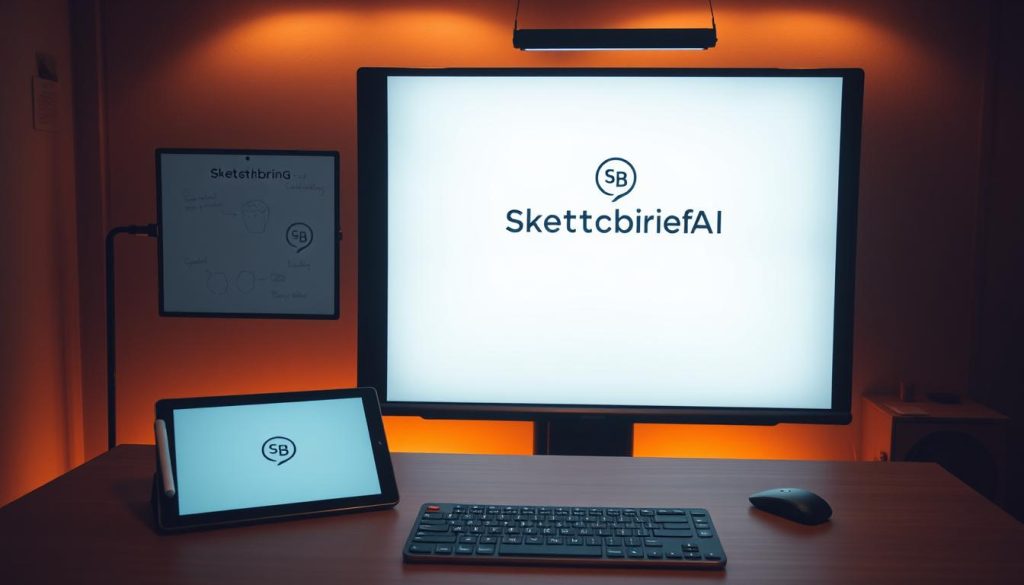Can moving a pile of sticky notes into a shared online canvas actually speed your team from ideas to decisions? We ask because the right process and tools turn scattered thoughts into clear action.
We show how replacing paper notes with a digital workflow cuts lost ideas and keeps your team aligned in real time. A clear agenda and a focused problem statement give every participant a way to contribute.
Quantity-first ideation and deferred judgment protect creativity while momentum builds. When we capture voice, text, and diagrams in one place, you avoid retyping and wasted time.
Facilitators use timers, roles, and light structure to move the group from divergent thinking to a prioritized plan. The result is faster decisions, durable records, and fewer follow-up meetings.
Key Takeaways
- Move sticky notes into a shared canvas to preserve and organize every idea.
- Set a clear problem and agenda to focus team contributions.
- Prioritize quantity of ideas early; defer judgment to protect creativity.
- Use tools that capture voice, text, and diagrams to speed execution.
- Apply simple facilitation—timers and roles—to keep momentum and ownership.
Why digitize your brainstorming session today
A fast online workspace preserves momentum and turns scattered thoughts into clear outcomes. We keep the process simple so your team can produce many ideas first, then refine quickly.
From quantity of ideas to quality outcomes in digital spaces
Quantity-first ideation on a digital canvas lets people add ideas without interruption. Then you cluster, vote, and lift the best concepts into action.
Benefits for distributed and hybrid teams in the United States
- Real-time co-editing and asynchronous input give remote members equal footing.
- Timers, private mode, and anonymous voting expand participation from a wide range of participants.
- Recording and transcription capture every idea so you reference exact wording later.
- Exporting outcomes into project tools turns decisions into tasks with owners and dates, saving time.
Set the stage: people, purpose, and psychological safety
Before you start generating ideas, align people, purpose, and the rules that keep conversations productive.
Invite a diverse mix of team members and stakeholders. We recommend including product, design, operations, and at least one external stakeholder. Diverse members reduce blind spots and widen solutions.
Define the problem and craft “How Might We” prompts
Translate your problem into crisp How Might We questions. Frame prompts neutrally to avoid bias and to spark many ideas from every participant.
Create a safe environment for open contribution
Set clear rules: no criticism, one conversation at a time, and build on others. A facilitator introduces the agenda, roles, and timebox so people know constraints and intent.
| Role | Purpose | Ground Rule |
|---|---|---|
| Facilitator | Set tone, enforce rules | One conversation at a time |
| Note-taker | Capture ideas and decisions | No editing during ideation |
| Timekeeper | Protect timeboxes | Strict start/stop |
Build your shared space: tools that replace sticky notes
Pick a single digital canvas so your team can add, cluster, and act on ideas without losing context.

Online whiteboards and visual thinking
Miro and Lucidspark serve as a central canvas with templates, clustering, timers, and anonymous voting. They speed co-creation and keep all thoughts in one place for easy sharing.
Mind mapping and flowcharts for structure
XMind and Lucidchart help when the problem needs decomposition or a clear process map. Use them to translate loose ideas into organized diagrams and summaries.
Idea management and voting
Qmarkets adds tagging, deduplication, AI similarity checks, and ranking so the best ideas surface quickly. This layer is key when many contributions need fair evaluation.
AI notetakers and transcription
Record and transcribe with Zoom or Nutshell Notetaker to capture every note verbatim. Transcripts become a searchable knowledge base for follow-up work.
- Use the whiteboard for divergence, the idea platform for triage, and your task system for execution.
- Standardize templates, enable private mode to reduce anchoring, and color-code for quick context.
- Set permission rules so guests can contribute without risking workspace governance.
brainstorming session digitize: a step-by-step workflow
We follow a tight, repeatable flow that turns open thinking into clear next steps. Start by sharing a brief agenda that lists timeboxes, roles, and the workspace link so everyone arrives prepared.
Create and share the agenda with timeboxes and roles
Publish the agenda before the meeting. Name the facilitator, scribe, and decision-maker.
Include explicit timeblocks and the link to your canvas so the team can join and start immediately.
Warm-ups and icebreakers to spark creativity
Run a two-minute warm-up—word association or a quick image prompt. It lowers friction and primes the group for divergent thinking.
Run the ideation: quantity over quality, defer judgment
We instruct the group to produce many ideas and hold critique. Use silent writing or private mode so everyone contributes without anchoring.
Capture, tag, and cluster ideas in real time
Tag items by theme, customer segment, or feasibility as they appear. Then cluster similar contributions to reveal patterns.
“Anonymous voting and clear headlines turn raw contributions into prioritized, testable directions.”
Finish by summarizing top clusters, confirming decisions, and converting select items into tasks with owners and dates. Schedule follow-ups in the same workspace so momentum continues after the meeting.
Choose proven digital methods for effective brainstorming
Match method to challenge so your team spends energy where it matters. We pick approaches that surface many ideas quickly, keep participation fair, and reveal leverage points for action.
Mind mapping helps when the problem is complex. Place the core problem at the center, expand to variables, and use visual hierarchy to reveal relationships and priorities.
Round Robin structures turn-taking so participants build on others in sequence. The result is layered ideas that reduce dominance and increase cohesion.
Brainwriting runs in silence: people write, pass notes, and iterate. It raises throughput and gives quieter participants equal influence.
Brainwalking adds movement—teams rotate between stations to refresh energy and cross-pollinate topics. Use it as an opener to break fixation.
Braindump clears mental queues before group work. Give 3–10 minutes for one idea per note, then group duplicates and move to voting or matrices.
“Use method-specific templates, clear timeboxes, and a fast converge step—theme, label, and log—so every round produces usable outcomes.”
| Method | Best for | Key rule |
|---|---|---|
| Mind map | Complex, variable-heavy problems | Center problem; expand outward |
| Round Robin | Collaborative building | Equal turns, fixed order |
| Brainwriting | High volume, inclusive output | Silent writing; timed passes |
| Brainwalking | Energy and cross-pollination | Rotate stations; limit attachments |
| Braindump | Session warm-up and unblock | One idea per note; quick grouping |
Facilitation essentials that make sure everyone participates
Good facilitation keeps ideas flowing while every person stays heard and on task. We design the environment so your team focuses on the problem and contributes without fear.

Use timers, private mode, and anonymous voting
Set clear timeboxes (15–60 minutes for core work) and enforce them. Timers protect focus and keep the group moving from divergence to converge.
Private mode lets people capture thoughts silently. Reveal contributions together to reduce anchoring and make sure everyone adds before critique starts.
Anonymous voting lowers hierarchy bias. Define voting rules, set a short time limit, and convert top picks into action items.
Visual scribing with color-coding, tags, and clusters
One person translates spoken notes into legible sticky notes, tags, and colors. Color-coding by theme speeds clustering and later prioritization.
- The facilitator enforces one conversation at a time and watches for drift.
- Use explicit turn-taking or a chat queue to balance airtime across participants.
- Log method shifts and place assumptions or risks on a separate layer to avoid derailing ideation.
“Close with a visible recap—top clusters, decisions, and next actions—so participants leave aligned and confident.”
From ideas to decisions: prioritize with transparency
We convert grouped inputs into a short list of testable options and a visible plan. Start by grouping and labeling related ideas so prioritization works on themes, not isolated notes.
Group, vote, and score
Group similar ideas and assign visual tags—customer value, risk, dependencies. Then run dot-voting with clear vote limits and a short timebox.
After votes, apply a criteria matrix—impact vs. effort or Now-Wow-How—to rank clusters. Narrate scores aloud so the whole team understands trade-offs.
Set metrics and pick a focused plan
Define leading and lagging success metrics before you choose. Attach a concise summary and owners to each shortlisted cluster.
“Transparent voting and clear metrics turn ideation into accountable action.”
| Step | Purpose | Outcome |
|---|---|---|
| Group & Tag | Reduce duplication; show themes | Themed clusters with labels |
| Dot-vote | Gauge interest quickly | Shortlist top clusters |
| Criteria Matrix | Expose trade-offs | Ranked, feasible options |
| Assign Metrics & Owners | Link to business goals | Measurable plan with deadlines |
Capture dissenting views in comments so context survives without blocking decisions. Timebox the converge step and outline a small validation plan for key assumptions.
Convert decisions into action plans your team can own
We translate high-potential ideas into tracked tasks so nothing stalls after the meeting.
Selected proposals become concrete work with owners, deadlines, and dependencies inside your tools. That removes handoff friction and keeps momentum moving toward measurable outcomes.
Assign tasks, owners, and deadlines inside your tools
Export chosen notes and clusters into your project system. Create tasks, set due dates, and link each task back to the original idea and cluster for context.
We recommend adding a short rationale and success metric to every task so priorities stay clear to team members.
Create follow-ups and checkpoints for progress
Schedule lightweight, timeboxed follow-ups to review progress and clear blockers. Use checkpoints tied to success metrics rather than status updates alone.
“Automations that notify owners of due dates and status changes reduce manual coordination and keep teams accountable.”
Document outcomes so sessions become a reusable knowledge base
Attach transcripts, whiteboard exports, and decision logs to the task or knowledge base. This preserves rationale and lets future teams find past work by topic and date.
For complex initiatives, use a simple RACI view and a closeout routine: what shipped, what we learned, and what to recycle.
| Action | Why it matters | Tool tip |
|---|---|---|
| Export selected ideas | Preserves context; prevents rework | Use board export to CSV or native task sync |
| Assign owners & deadlines | Creates accountability | Auto-notifications for due dates |
| Schedule checkpoints | Tracks progress against metrics | Recurring 15–30 min reviews |
| Attach transcripts & exports | Keeps decisions searchable | Link artifacts to tasks and knowledge repo |
| Closeout & index | Turns learning into reuse | Maintain an indexed archive by topic/date |
Quick checklist: convert ideas into tasks, link context, set owners and deadlines, schedule checkpoints, attach artifacts, and run a closeout. These steps make ideation repeatable, auditable, and productive.
Advanced tips for modern teams: AI, remote-first, and accessibility
Combine lightweight AI assists with remote-friendly routines to make every idea count. We pair automated clustering and summarization with simple rules so contributions from a wide range of participants remain visible and actionable.
Leverage AI to summarize, cluster, and expand ideas
Use AI to suggest variations on themes, generate sharp How Might We prompts, and surface contradictions that refine the problem. AI can auto-cluster similar notes, tag duplicates, and produce meeting summaries that speed documentation.
Optimize for hybrid participation and time zones
Run async pre-reads and idea windows so remote members contribute without missing live work. We recommend live divergence, async refinement, and scheduled reviews for decisions.
- Store recordings, transcripts, and summaries in one searchable place.
- Enable captions, keyboard-first navigation, and screen-reader-friendly boards for accessibility.
- Set clear etiquette for chat, reactions, and raised hands to keep order across time zones.
“Small experiments with AI tools reveal the best ways to boost throughput and quality.”
Conclusion
Finish strong by converting select ideas into measurable work and shared accountability. We recap the path: define a clear problem, craft crisp questions, and run a structured, digital-first ideation flow that protects creativity and time.
You saw how shared workspaces, templates, and simple rules help participants focus and move from many ideas to confident decisions. Clustering, transparent voting, and a criteria matrix give prioritization credibility and speed.
Convert outcomes into tasks with owners and deadlines so momentum becomes measurable. Recordings and transcripts turn every session into searchable organizational memory.
Choose your core tools, adopt the step-by-step workflow, and schedule your first digitized session this month. With discipline and iteration, you’ll build a repeatable practice of effective brainstorming that consistently delivers results.

Leave a Reply